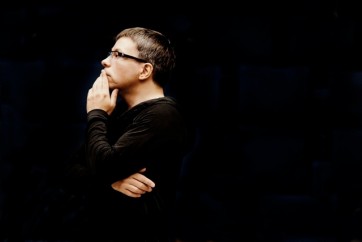Plus de détails
Espoo. Tapiola Hall. 11-III-2016. Maurice Ravel (1875-1937): Ma mère l’Oye; Piano Concerto; Erkki-Sven Tüür (b. 1959): Symphony No. 8. Frank Braley : piano; Tapiola Sinfonietta, conductor: Olari Elts.
 Frank Braley's performance was completely natural, effortless, and thoroughly integrated with both his musical and pianistic philosophy.
Frank Braley's performance was completely natural, effortless, and thoroughly integrated with both his musical and pianistic philosophy.
The music of the Estonian composer Erkki-Sven Tüür is often performed in Helsinki, largely due to the regular podium presence of his compatriot Olari Elts. This evening's program featured Tüür's Symphony No. 8, coupled with works from Ravel.
The program opened with Ravel's Ma mère l'Oye. Right from the start one could appreciate the clarity of texture brought by the use of chamber forces. The second movement, while confidently played, felt slightly pedantic at times. The third movement was more successful, as Elts paid special attention to the Ravel's very effective percussion writing. Erkki Suomalainen's excellent contrabassoon solo (as the “beast”) was the highlight of the fourth movement, and Elts coaxed quietly rapturous, almost painfully beautiful playing from the Tapiola strings in the final movement.
Ravel's Piano Concerto is firmly established in the repertoire and performances of this masterpiece are frequent. Accordingly, it is expected that any pianist on the international circuit can provide at least a technically satisfying performance. However, a soloist shows true greatness when they demonstrate a genuine unity with the music; the soloist simply serves as a medium through which the composer is channeled.
Such was the case with tonight's soloist, Frank Braley. His performance was completely natural, effortless, and thoroughly integrated with both his musical and pianistic philosophy. It was almost as if his mere presence at the piano was sufficient to bring this music into being. He brought a balletic grace to the first movement's flourishes and glissandi, and extracted just that extra bit of cheekiness in the third movement. While I personally prefer a sentimental but measured approach to the beautiful central movement, Braley's interpretation brought gracefulness and purity.
Following intermission came Erkki-Sven Tüür's most recent symphony, a commission from the Scottish Chamber Orchestra. Listeners familiar with Tüür's orchestral output probably found themselves in mostly familiar territory.
The work opened with a noodling, chromatic gesture, answered by bubbling woodwinds. Strings responded with skittering, but propulsive counterpoint. Tüür hinted at his affinity for rock music, particularly in the use of drum kit, but this was a fleeting glance in comparison to his earlier works such as Exodus or the Symphony No. 5. The second movement referenced the work's opening gesture, but here the musical motion shifted in large, static blocks of sound. A seamless transition to the third and final movement led to an exciting and rousing conclusion.
While Tüür's mastery of his material and clarity of musical argument was impressive, I found the overall effect to be somewhat ambivalent. However, in my experience repeated listenings are sometimes necessary to arrive at a deeper appreciation of Tüür's music, and I imagine this applies to the Symphony No. 8.
Credit photo : Olari Elts (c) Marco Borggreve
Plus de détails
Espoo. Tapiola Hall. 11-III-2016. Maurice Ravel (1875-1937): Ma mère l’Oye; Piano Concerto; Erkki-Sven Tüür (b. 1959): Symphony No. 8. Frank Braley : piano; Tapiola Sinfonietta, conductor: Olari Elts.







